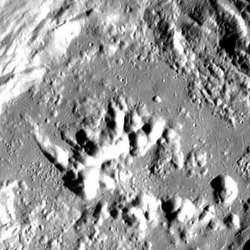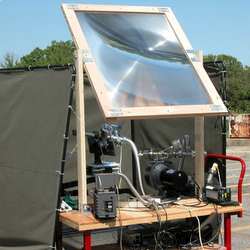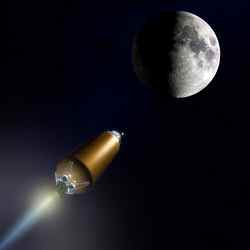It might sound hard to believe, but dozens of spacecraft have crashed themselves onto the surface of the Moon. All in the name of science. The first was the Soviet spacecraft Luna 2, which smashed into the lunar surface in 1959. Well, an upcoming mission is all set to do it again. NASA’s Lunar CRater Observation and Sensing Satellite (LCROSS) will launch in 2008 together with the Lunar Reconnaissance Orbiter. Its booster rocket will smash into the Moon first, carving out a large crater, and then the smaller Shepherding spacecraft will smash into the same spot, analyzing the debris cloud before it’s destroyed too.
Continue reading “Crashing Into the Moon… On Purpose”
No, Mars Won’t Look as Big as the Moon in August
Have you gotten a copy of the email yet? If you haven’t, you probably will. Forwarded from a friend, forwarded again and again until the original source is lost in the murky cloud of the Internet, it encourages you to get set for the experience of a lifetime. When MARS WILL LOOK AS LARGE AS THE FULL MOON!!!!! Is this going to happen? No. But there’s a strange gem of truth at the heart of this misunderstanding/hoax. I’ll give you the history and then everything you need to explain what’s going on to your excited but misinformed email forwarding friends.
Continue reading “No, Mars Won’t Look as Big as the Moon in August”
Gassendi Crater on the Moon
ESA’s SMART-1 spacecraft captured this image of crater Gassendi on the Moon. The spacecraft’s advanced Moon Imaging Experiment (AMIE) captured the photograph on January 13 at a distance of 1220 km (760 miles) from the surface. Gassendi is an impact crater on the near side of the Moon, but it’s unusual because it seems to have large quantities of volcanic material on the crater floor.
Continue reading “Gassendi Crater on the Moon”
Strange Lunar Swirls
Point your telescope at the Moon, and you might see features known as Lunar Swirls. These flat features look like cream just mixed into coffee; except it’s pale moondust in swirling patterns atop darker terrain. Even stranger, these swirls have different magnetic fields than the surrounding terrain. What causes them? One theory is that the magnetic field protects the lunar soil from being darkened by solar radiation, creating an unusual dark and light pattern.
Continue reading “Strange Lunar Swirls”
SMART-1 Prepares for the End
ESA’s SMART-1 has been orbiting the Moon for 16 months, but it’s out of fuel, so its life is almost over. On September 3, 2006, it will crash into the Moon’s surface in a final act of science. If its orbit was to decay naturally, the spacecraft would impact on the far side of the Moon; however controllers have devised a strategy to help it impact on the near side, in view of Earth-based telescopes.
Continue reading “SMART-1 Prepares for the End”
Meteoroid Strike on the Moon
NASA researchers fortunate enough to be recording the Moon through a 10″ telescope equipped with a video camera when they saw a meteoroid strike. The spacerock was only 25 cm (10 inches) wide, but it released 17 billion joules of kinetic energy; the same as 4 tons of TNT. The resulting flash was quick, only lasting 4/10ths of a second, but it was powerful enough to carve out a crater 14 metres (46 feet) wide.
Continue reading “Meteoroid Strike on the Moon”
Central Peaks of Zucchius Crater

Crater Zucchius captured by SMART-1. Image credit: ESA. Click to enlarge
This is a photograph of the central peaks of crater Zucchius, located on the Moon. ESA’s SMART-1 took the photo while it was about 753 kilometres (468 miles) above the surface of the Moon. The crater was formed in the Copernican era, a period that began 1.2 billion years ago. These central mountains are formed when a large object struck the Moon; the molten rocks splashed up and hardened into this shape.
This image, taken by the advanced Moon Imaging Experiment (AMIE) on board ESA’s SMART-1 spacecraft, shows the central peaks of crater Zucchius.
AMIE obtained this image on 14 January 2006 from a distance of about 753 kilometres from the surface, with a ground resolution of 68 metres per pixel.
The imaged area is centred at a latitude of 61.3 South and longitude 50.8 West. Zucchius is a prominent lunar impact crater located near the southwest limb. It has 66 kilometres diameter, but only its inside is visible in this image, as the AMIE field of view is 35 kilometres from this close-up distance.
Because of its location, the crater appears oblong-shaped due to foreshortening. It lies just to the south-southwest of Segner crater, and northeast of the much larger Bailly walled-plain. To the southeast is the Bettinus crater, a formation only slightly larger than Zucchius.
Zucchius formed in the Copernican era, a period in the lunar planetary history that goes from 1.2 thousand million years ago to present times. Another example of craters from this period are Copernicus (about 800 milion years old) and Tycho (100 million years old). Craters from the Copernican era show characteristic ejecta ray patterns – as craters age, ejecta rays darken due to weathering by the flowing solar wind.
The hills near the centre of the image are the so-called ‘central peaks’ of the crater, features that form in large craters on the Moon. The crater is formed by the impact of a small asteroid onto the lunar surface. The surface is molten and, similarly to when a drop of water falls into a full cup of coffee, the hit surface bounces back, it solidifies and then ‘freezes’ into the central peak.
The name of Zucchius crater is due to the Italian Mathematician and astronomer Niccolo Zucchi (1586-1670).
Original Source: ESA Portal
Air From Moonrocks

A focusing lens to produce oxygen and slug from a vacuum moondust filled chamber. Image credit: NASA. Click to enlarge
When astronauts return to the Moon, to explore and eventually build a moon base, they’re going to need oxygen… and lots of it. Fortunately lunar soil – or regolith – is almost half oxygen. NASA researchers are using a technique called vacuum pyrolysis, where the regolith is heated until it releases oxygen. Light from the Sun was focused by a lens to heat lunar soil to 2,500 degrees C. As much as 20% of the soil was converted to free oxygen, and the leftover slag could be used for bricks, radiation shielding or pavement.
An early, persistent problem noted by Apollo astronauts on the Moon was dust. It got everywhere, including into their lungs. Oddly enough, that may be where future Moon explorers get their next breath of air: The moon’s dusty layer of soil is nearly half oxygen.
The trick is extracting it.
“All you have to do is vaporize the stuff,” says Eric Cardiff of NASA’s Goddard Space Flight Center. He leads one of several teams developing ways to provide astronauts oxygen they’ll need on the Moon and Mars. (See the Vision for Space Exploration.)
Lunar soil is rich in oxides. The most common is silicon dioxide (SiO2), “like beach sand,” says Cardiff. Also plentiful are oxides of calcium (CaO), iron (FeO) and magnesium (MgO). Add up all the O’s: 43% of the mass of lunar soil is oxygen.
Cardiff is working on a technique that heats lunar soils until they release oxygen. “It’s a simple aspect of chemistry,” he explains. “Any material crumbles into atoms if made hot enough.” The technique is called vacuum pyrolysis–pyro means “fire”, lysis means “to separate.”
“A number of factors make pyrolysis more attractive than other techniques,” Cardiff explains. “It requires no raw materials to be brought from Earth, and you don’t have to prospect for a particular mineral.” Simply scoop up what’s on the ground and apply the heat.
In a proof of principle, Cardiff and his team used a lens to focus sunlight into a tiny vacuum chamber and heated 10 grams of simulated lunar soil to about 2,500 degrees C. Test samples included ilmenite and Minnesota Lunar Simulant, or MLS-1a. Ilmenite is an iron/titanium ore that Earth and the Moon have in common. MLS-1a is made from billion-year-old basalt found on the north shore of Lake Superior and mixed with glass particles that simulate the composition of the lunar soil. Actual lunar soil is too highly prized for such research now.
In their tests, “as much as 20 percent of the simulated soil was converted to free oxygen,” Cardiff estimates.
What’s leftover is “slag,” a low-oxygen, highly metallic, often glassy material. Cardiff is working with colleagues at NASA’s Langley Research Center to figure out how to shape slag into useful products like radiation shielding, bricks, spare parts, or even pavement.
The next step: increase efficiency. “In May, we’re going to run tests at lower temperatures, with harder vacuums.” In a hard vacuum, he explains, oxygen can be extracted with less power. Cardiff’s first test was at 1/1,000 Torr. That is 760,000 times thinner than sea level pressure on Earth (760 Torr). At 1 millionth of a Torr — another thousand times thinner — “the temperatures required are significantly reduced.”
Cardiff is not alone in this quest. A team led by Mark Berggren of Pioneer Astronautics in Lakewood, CO, is working on a system that harvests oxygen by exposing lunar soil to carbon monoxide. In one demonstration they extracted 15 kg of oxygen from 100 kg of lunar simulant–an efficiency comparable to Cardiff’s pyrolysis technique: more.
D.L. Grimmett of Pratt & Whitney Rocketdyne in Canoga Park, CA, is working on magma electrolysis. He melts MLS-1 at about 1,400 deg. C, so it is like magma from a volcano, and uses an electric current to free the oxygen: more.
Finally, NASA and the Florida Space Research Institute, through NASA’s Centennial Challenge, are sponsoring MoonROx, the Moon Regolith Oxygen competition. A $250,000 prize goes to the team that can extract 5 kg of breathable oxygen from JSC-1 lunar simulant in just 8 hours.
The competition closes June 1, 2008, but the challenge of living on other planets will last for generations.
Got any hot ideas?
Original Source: NASA News Release
Crater Hopmann by SMART-1
ESA’s SMART-1 spacecraft captured this photograph of Crater Hopmann, located on the Moon. Only a quarter of the full crater is visible in this photograph, and it contains several other smaller craters inside of it. The small crater chains are created when secondary debris is blasted off the surface of the Moon, and then falls back in an arc of molten droplets. This area isn’t visible from the Earth because it’s on the far side of the Moon – only spacecraft have ever seen it.
This image, taken by the advanced Moon Imaging Experiment (AMIE) on board ESA’s SMART-1 spacecraft, shows one quarter of crater Hopmann – an impact structure about 88 kilometres in diameter.
AMIE obtained this image on 25 January 2006 from a distance of about 840 kilometres from the surface, with a ground resolution of 76 metres per pixel.
The imaged area, not visible from Earth because it is located on the far side of the Moon, is positioned at latitude of 51.7 degrees South and longitude 159.2 degrees East. It covers a square of about 39 kilometres per side.
The crater (centred at 50.8 degrees South, 160.3 degrees East) is situated on the edge of the giant South Pole-Aitken basin SPA, the largest impact crater in the solar system with a diameter of 2500 kilometres and a depth of 13 kilometres. The SPA basin shows distinctive chemical composition with unusual mineralogy types, and possible exposure of rocks from the lower crust or the upper mantle.
The hills on the lower left side are the crater wall of Hopmann. This crater is very old – many small craters can be seen on its flat floor, the largest one showing an interesting double-ringed structure. The outer rim has been also eroded by later impacts.
The small crater chains to the left of Hopmann can be interpreted as series of so-called ‘secondary craters’, created by the impact of the material ejected from a nearby large impact. This ejected material flies away in molten state, and fall in large ‘droplets’. When these impact on the surface, they form typical crater chains as those visible in this image.
The crater is named after Josef Hopmann (1890-1975), an astronomer that worked in Bonn, Leipzig and as Director of the Vienna Observatory.
Original Source: ESA Portal
New Spacecraft Will Search for Lunar Ice

An artist’s conception of LRO on its way to the moon. Image credit: NASA Click to enlarge
NASA announced a new spacecraft today that will search for ice at the Moon’s southern pole: the Lunar CRater Observation and Sensing Satellite (LCROSS). The spacecraft will launch as a secondary payload with the Lunar Reconnaissance Orbiter in 2008. As it approaches the Moon, LCROSS will split into two spacecraft. The first will smash into the Moon’s south pole, and the second will fly through the resulting plume, analyzing it for traces of water. This mission will be developed on a shoestring; NASA has allocated a total of $80 million for its development.
NASA today announced that a small, ‘secondary payload’ spacecraft, to be developed by a team at NASA Ames Research Center, Moffett Field, Calif., has been selected to travel to the moon to look for precious water ice at the lunar south pole in October 2008.
The smaller secondary payload spacecraft will travel with the Lunar Reconnaissance Orbiter (LRO) satellite to the moon on the same rocket, the Evolved Expendable Launch Vehicle (EELV), to be launched from Kennedy Space Center, Florida. The NASA Ames team proposed the secondary payload mission, which will be carried out by the Lunar CRater Observation and Sensing Satellite (LCROSS).
“The LCROSS mission gives the agency an excellent opportunity to answer the question about water ice on the moon,” said Daniel Andrews of NASA Ames, whose team proposed the LCROSS mission. “We think we have assembled a very creative, highly innovative mission, turning the upper stage of the rocket that brought us to the moon into a substantial impactor on the moon.”
After launch, the secondary payload LCROSS spacecraft will arrive in the lunar vicinity independent of the LRO satellite. On the way to the moon, the LCROSS spacecraft’s two main parts, the Shepherding Spacecraft (S-S/C) and the Earth Departure Upper Stage (EDUS), will remain coupled.
As the spacecraft approaches the moon’s south pole, the upper stage will separate, and then will impact a crater in the south pole area. A plume from the upper stage crash will develop as the Shepherding Spacecraft heads in toward the moon. The Shepherding Spacecraft will fly through the plume, and instruments on the spacecraft will analyze the cloud to look for signs of water and other compounds. Additional space and Earth-based instruments also will study the 2.2-million-pound (1000-metric-ton) plume.
“The LCROSS mission will help us determine if there is water hidden in the permanently dark craters of the moon’s south pole,” said Marvin (Chris) Christensen, Robotic Lunar Exploration Program (RLEP) manager, and acting director of NASA Ames. “If we find substantial amounts of water ice there, it could be used by astronauts who later visit the moon to make rocket fuel,” Christensen added.
Earlier, NASA had requested proposals internally from its NASA field centers for existing or reasonably matured concepts for secondary payloads that would offer cost-effective contributions to RLEP.
To prepare for the return of astronauts to the moon, NASA will conduct various RLEP robotic missions from 2008 to potentially 2016 to study, to map and to learn about the lunar surface. These early missions will help determine lunar landing sites and whether resources, such as oxygen, hydrogen and metals, are available for use in NASA’s long-term lunar exploration objectives.
“Establishing research stations on the moon will give us the experience and capabilities to extend to Mars and beyond,” noted robotics deputy program manager Butler Hine of Ames.
“An exploration science program with a sustained human presence on the moon gives us the opportunity to conduct fundamental science in lunar geology, history of the solar system, physics and the biological response to partial (Earth) gravity,” said Christopher McKay, lunar exploration program scientist at Ames.
The space agency specified that the winning proposal must demonstrate an affordable concept beneficial to RLEP, according to the document that asked NASA centers to submit suggestions for the secondary payload. NASA noted that the secondary payload mission should cost no more than $80 million. NASA also required that the payload mass not exceed 2,205 pounds (1,000 kilograms).
NASA encouraged its field centers to team with industry to develop proposals. On Jan. 10, NASA issued a request for information to industry to allow businesses to provide secondary payload concepts to NASA. Each NASA center reviewed ideas from industry as well as secondary payload concepts developed internally.
NASA asked that the concepts advance the Vision for Space Exploration to include missions that evolve lunar science, characterize the lunar environment and support identification sites for future human missions as well as the utility of those sites.
The space agency said that it was looking for missions that demonstrate technology that could enhance future exploration, that show operational schemes to support exploration, that develop or emplace infrastructure in support of exploration, that advance commercial opportunities and those missions that would collect engineering data to support the Constellation program. That program is developing NASA’s new spaceship, the Crew Exploration Vehicle.
For images related to the LCROSS mission, please visit:
http://www.nasa.gov/centers/ames/multimedia/images/2006/lunarorbiter.html
For additional high-resolution images of the and historic information, please visit:
http://www.nasa.gov/centers/ames/news/releases/2004/moon/moon.html
http://nssdc.gsfc.nasa.gov/planetary/lunarprosp.html
http://science.nasa.gov/newhome/headlines/ast31jul99_1.htm
Original Source: NASA News Release
